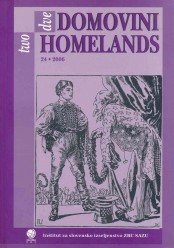SELITVE ŽENSK IZ GABERIJ V VIPAVSKIH BRDIH MED LETI 1920–1954
Ključne besede:
brangerca, kontrabant, krožne selitve, izseljevanje, Vipavska BrdaPovzetek
V prispevku so predstavljene trgovske poti Gaberk ter vpliv le-teh na vlogo ženske v družini in vasi. Ženske iz Vipavskih brd so se odpravljale na pot ne v želji po bogatenju, ampak v nuji po preživetju. Zaradi razmer, v katerih so živele, je bilo njihovo življenje kmečke gospodinje vse prej kot vpeto med štiri stene. Igrale so več vlog: bile so matere, žene, snahe, vaščanke, trgovke, tihotapke oziroma kontrabantke, mogoče celo nekoliko avanturistke in ne nazadnje migrantke oziroma selivke. Selile so se v bližnja mesta in po podeželju ter tako krožile med domom in virom zaslužka za osnovne življenjske potrebe. Predvsem ženske z majhnimi otroki so iskale srednjo pot in se tako niso trajno izselile, ampak le krožile. Tako so še vedno lahko opravljale vlogo matere in žene ter skrbele za dotok denarja v gospodinjstvo.
Beseda, s katero ženske same označujejo svoje trgovske poti in sebe, je brangerstvo oziroma brangerca. To je ženska, ki je v obravnavanem obdobju na razne načine nosila jajca, maslo, sezonsko zelenjavo, maline, meso, žganje in druge pridelke v italijanska mesta, jih tam prodala ali menjala in prinesla domov nekaj denarja ali menjanih živil in gospodinjskih potrebščin, ki jih sicer ni bilo moč kupiti (testenine, milo). Na potek trgovskih poti je vplivalo spreminjanje političnih razmer in posledično državnih meja.
Vzroki za selitve vsake od Gaberk so večpomenski. Čeprav jih v grobem lahko zaobjamemo z družbeno gospodarskim položajem (vsaka sogovornica pove, da je bila glavni razlog za selitve revščina), ima vsaka ženska svojo zgodbo in sebi lastne motive. V ospredje postavljena Olgina zgodba se ujema z zgodbami ostalih Gaberk in je dragocena, saj je tudi Olga sama hodila v Trst ter po ostalih poteh, ki jih je pred njo prehodila njena mati.
Čeprav so bile poti nedvomno fizično naporne, so ženske tako prišle v stik s svetom, ki ni bil viden iz domače vasi. Videle so Trst, veliko, v njihovih očeh in tudi sicer bogato mesto. Poti v manjših skupinah žensk, ki so se poznale, so bile vse prej kot trgovski pohod v tišini. Ženske so se šalile, smejale, prepevale, si delile nasvete – tako trgovske kot tiste, bolj povezane z družinskim življenjem.
Denar, ki so ga brangerce dobile, je predstavljal njihovo vsaj delno finančno samostojnost. Poti so jim predstavljale krajši odmik od otrok in moža ter bile pravzaprav njihov lasten čas. Zaslužen denar je vplival tudi na socialni razvoj vasi, spremembe statusa ženske, družinske trdnosti in tradicionalnih socialnih vzorcev zakonske stabilnosti. V Gaberjah je moč žensk znotraj družine narasla, saj so imele dostop do lastnega denarja. Čeprav so ga porabile za družino, predvsem za otroke in prehrano, so o tem odločale one. Življenjski standard družin se je, čeprav počasi, dvigal tudi zaradi njihovih poti.
Prenosi
Literatura
Barbič, Ana in Miklavčič Brezigar, Inga (1999). Občasne migracije podeželskih žena na Goriškem. Gospodinjsko delo v tujini - nuja in priložnost nekoč in danes. Ljubljana: Glasnik slovenskega etnološkega društva 39, 3/4, str. 39—48.
Bezlaj, France (1976). Etimološki slovar slovenskega jezika. Prva knjiga. Ljubljana: Mladinska knjiga. Izdala Slovenska akademija znanosti in umetnosti. Inštitut za slovenski jezik.
Brumen, Borut, ur. (2000). Sveti Peter in njegovi časi. Socialni spomini, časi in identitete v istrski vasi Sv. Peter, Ljubljana: *cf., str. 121-265.
Drnovšek, Marjan (1999). Izseljevanje Slovencev v razvite evropske države do leta 1940. Slovenska izseljenska književnost 1 (ur. Janja Žitnik). Ljubljana: ZRC: Rokus, str. 29-60.
Drnovšek, Marjan (2002). Mobilnost Slovencev in regionalizem. Zgodovinski časopis 56, 3/4, str. 259-276.
Drnovšek, Marjan (2004). Izseljenke v očeh javnosti. Zbornik referatov 32. zborovanja slovenskih zgodovinarjev (ur. Aleksander Žižek). Ljubljana: Zveza zgodovinskih društev Slovenije, str. 383-393.
Gabršček, Andrej (1934). Goriški Slovenci. Narodne, kulturne, politične in gospodarske črtice. Druga knjiga. Od leta 1901 do 1924. Ljubljana: samozaložba, str. 570.
Gombač, Jure (2004). Sociološki vidiki migracijskih gibanj v slovenski Istri v luči londonskega memoranduma: doktorska disertacija. Ljubljana: Univerza v Ljubljani, Oddelek za sociologijo, str. 120-129.
Kalc, Aleksej ur. (2002). Poti in usode: selitvene izkušnje Slovencev z zahodne meje. Koper: Znanstveno-raziskovalno središče Republike Slovenije, Trst: Narodna in študijska knjižnica, Annales Majora, str. 13^17.
Kodre, Petra (1996). Nanoška planota je raztresala svoj sad med pridne dolinske kmete. V: Rosa, Jurij, ur., St. Vid-Podnanos: zbornik prispevkov o kraju in njegovi zgodovini. Nova Gorica: Pokrajinski arhiv, str. 65-76.
Krajevni leksikon Slovenije (1968). Prva knjiga. Zahodni del Slovenije. Ljubljana: Državna založba Slovenije.
Ledinek, Špela in Rogelja, Nataša (2000). Potepanja po poteh Šavrinke Marije. Ljubljana: Slovensko etnološko društvo, 110 str.
Lukšič - Hacin, Marina (1995). Ko tujina postane dom: resocializacija in narodna identiteta pri slovenskih izseljencih. Ljubljana: Znanstveno in publicistično središče, str. 50.
Makuc, Dorica (1993). Aleksandrinke. Gorica: Goriška Mohorjeva družba, 171 str.
Mlekuž, Jernej (2004). Izbrani vidiki zaposlovanja beneških deklet v gospodinjstvih italijanskih mest: tiha, grenko-sladka, nikoli povsem izrečena in slišana zgodba. Dve domovini/Two Homelands 19, str. 141—164.
Ravnik, Mojca (2002). Z meje na mejo. V: Kalc, Aleksej, ur. Poti in usode: selitvene izkušnje Slovencev z zahodne meje. Koper: Znanstveno-raziskovalno središče Republike Slovenije, Trst: Narodna in študijska knjižnica, Annales Majora, str. 54—61.
Rodman, Marta in Makarovič, Marija (2000). Življenje ob Trti in kršinu. Življenjska pričevanja krajanov iz Vipave in okolice. Vipava: Občina Vipava, 205 str.
Valenčič, Vlado (1990). Izseljevanje Slovencev v tujino do druge svetovne vojne. Dve domovini/Two Homelands 1, str. 43-82.
Prenosi
Objavljeno
Kako citirati
Številka
Rubrike
Licenca

To delo je licencirano pod Creative Commons Priznanje avtorstva-Nekomercialno-Brez predelav 4.0 mednarodno licenco.
Avtorji jamčijo, da je delo njihova avtorska stvaritev, da v njem niso kršene avtorske pravice tretjih oseb ali kake druge pravice. V primeru zahtevkov tretjih oseb se avtorji zavezujejo, da bodo varovali interese založnika ter da bodo povrnili morebitno škodo.
Podrobneje v rubriki: Prispevki





